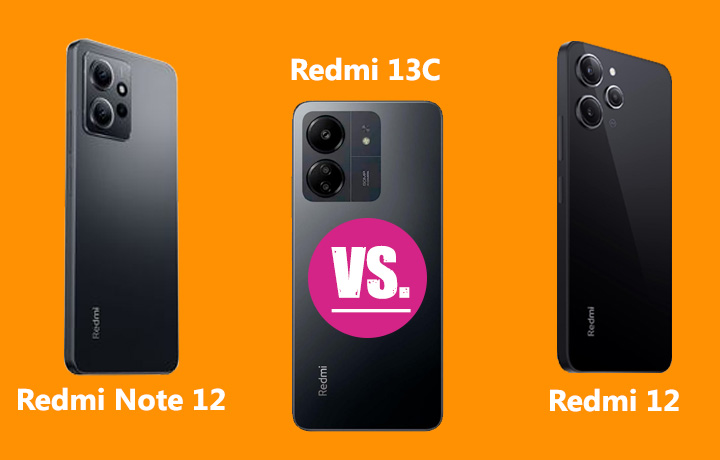Redmi Note 12 Vs Redmi 13c Vs Redmi 12: “Pros, Cons” And Reasons To Buy
In the ever-evolving world of budget smartphones, Xiaomi’s Redmi series has gained a reputation for offering impressive features at affordable prices. This comparison will delve into the Redmi Note 12, Redmi 12, and Redmi 13C, evaluating their specifications, performance, camera capabilities, battery life, and overall value for money.
- Read also:
- Best Flagship Phones Of 2024: All Pros And Cons And Everything You Need To Know
- iQOO 12 Pro Review: Striking a Balance Between Gaming and Elegance
Display:
The display is often a critical aspect of a smartphone, influencing the user’s overall experience. The Redmi Note 12 boasts a 1080p 120Hz AMOLED display, protected by Corning Gorilla Glass 3. This combination delivers sharp visuals, vibrant colors, and smooth motion, making it a standout feature. The inclusion of a hole-punch cutout adds to its modern aesthetics, enhancing the overall appeal.
On the other hand, the Redmi 12 features a 1080p 90Hz IPS LCD display with a hole-punch cutout. While it may not match the Note 12’s AMOLED quality, it still offers a solid viewing experience with accurate colors and good sharpness. The Redmi 13C, being the most budget-friendly, has a 720p 90Hz IPS LCD display. Despite the lower resolution, reviews suggest that it provides a visually appealing experience, especially considering its price point.
Processor and Performance:
The Redmi Note 12 takes the lead in terms of processing power, housing a Snapdragon 685 processor and an Adreno 610 GPU. This combination ensures smooth multitasking, efficient performance in demanding applications, and a superior gaming experience. The chipset’s superiority is highlighted when compared to the Redmi 12, which features the Helio G88 and Mali G52 MC2 GPU. Although not as powerful as the Note 12’s chipset, the Redmi 12’s configuration still offers commendable performance, especially in the context of its mid-range pricing.
The Redmi 13C, equipped with the Helio G85, is the least powerful among the three. While it may not match the performance of the other two, it still stands out as a reasonable choice for users on a tight budget. For casual users and those with basic smartphone needs, the Redmi 13C’s performance is likely to be satisfactory.
RAM and Storage:
All three smartphones provide flexibility in terms of RAM and storage options. The Redmi Note 12 supports up to 8GB of RAM and offers storage options of up to 256GB, utilizing the faster UFS 2.2 storage type. The Redmi 12 matches these specifications, providing users with up to 8GB of RAM and 256GB of storage.
The Redmi 13C, despite its budget-friendly positioning, maintains parity with the other models, offering up to 8GB of RAM and 256GB of storage. This ensures that users across all three models can enjoy seamless multitasking and ample storage capacity for their apps, media, and files.
- ALSO:
- Marshall Motif II ANC Review: “Pros & Cons” And Reasons To Buy It
- Insta360 Ace Pro Review: A Game-Changer in the Action Camera Arena
Camera Capabilities:
Camera performance is a crucial aspect for many smartphone users. While all three phones share the same main 50-megapixel camera, the Redmi Note 12 stands out due to its consistent ability to deliver high-quality photos. The inclusion of video stabilization further enhances its appeal, providing users with smoother and more professional-looking videos.
The Redmi 12, despite having a similar camera setup, falls slightly short in terms of consistency, especially in video recording. The absence of stabilization can result in shaky videos, which might be a drawback for users prioritizing video quality.
The Redmi 13C, although maintaining the same main camera as the other models, faces similar challenges with video quality due to the absence of stabilization. However, for its price, the camera performance is commendable, making it a reasonable choice for users with basic photography needs.
Battery Life and Charging:
Battery life is a critical consideration for users who rely on their smartphones throughout the day. All three models feature a 5,000mAh battery, ensuring a reliable duration between charges. However, the Redmi Note 12 takes the lead with its 33W fast charging support, allowing for quicker replenishment of the battery. This is a notable advantage, especially for users who need a quick top-up during their busy schedules.
The Redmi 12, while having the same battery capacity, supports 18W charging, which is slower compared to the Note 12. The Redmi 13C, despite being the most budget-friendly option, matches the Redmi 12 with 18W charging support. Pros.. Cons, and Pricing on the NEXT PAGE…





